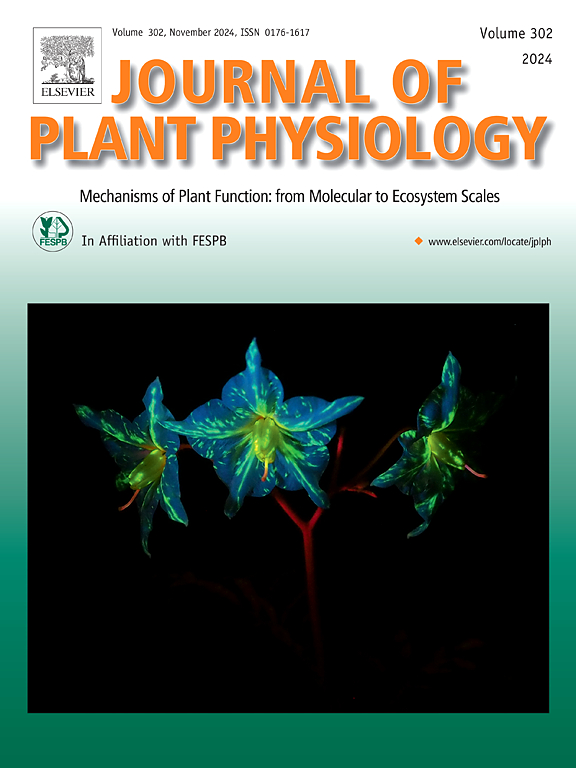Overexpression of the tomato nuclear-cytoplasmic shuttling bZIP transcription factor VSF-1 in Arabidopsis retards plant development under mannitol-stressed conditions
IF 4.1
3区 生物学
Q1 PLANT SCIENCES
引用次数: 0
Abstract
VASCULAR SPECIFICITY FACTOR 1 (VSF-1) is a basic leucine zipper transcription factor identified in tomato (Solanum lycopersicum L.). VSF-1 regulates vascular-specific gene expression and is homologous to an Arabidopsis thaliana mechanical stress regulator, VIP1, but physiological roles for VSF-1 remain unclear. Here, we demonstrate that VSF-1 shuttles between the nucleus and the cytoplasm in response to hypo-osmotic stress. In Arabidopsis plants overexpressing the VSF-1-GFP fusion protein, VSF-1-GFP was mainly detected in the cytoplasm under unstressed conditions but in the nucleus under hypo-osmotically stressed conditions. VSF-1 contains three serine residues within HXRXXS motifs, which can serve as its phosphorylation and 14-3-3 protein-binding sites. In a transient gene expression system in Nicotiana benthamiana leaves, GFP-fused VSF-1 variants where those serine residues were replaced with alanine exhibited nuclear accumulation even under unstressed conditions. GFP-fused VSF-1 variants lacking those HXRXXS motifs also exhibited such nuclear accumulation. The VSF-1 variants lacking those HXRXXS motifs failed to interact with 14-3-3 proteins in a yeast two-hybrid system. These findings suggest that the nuclear accumulation of VSF-1 is triggered by hypo-osmotic stress through its dissociation from 14-3-3 proteins, similar to that of VIP1. The Arabidopsis VSF-1-GFP-overexpressing lines exhibited retarded germination and growth in the presence of mannitol, which can induce hyper-osmotic stress and repress nuclear accumulation of VSF-1. These results are consistent with phenotypes from VIP1-GFP-overexpressing lines in a previous study, indicating a conserved role for VIP1 and VSF-1 in regulating osmotic stress responses.
甘露醇胁迫下,拟南芥核胞质穿梭bZIP转录因子VSF-1的过度表达会延缓植株发育
血管特异性因子1 (VASCULAR specific FACTOR 1, VSF-1)是在番茄(Solanum lycopersicum L.)中发现的一种亮氨酸拉链转录因子。VSF-1调节血管特异性基因表达,与拟南芥机械胁迫调节因子VIP1同源,但其生理作用尚不清楚。在这里,我们证明了VSF-1在低渗透胁迫下在细胞核和细胞质之间穿梭。在过表达VSF-1-GFP融合蛋白的拟南芥植物中,在非胁迫条件下主要在细胞质中检测到VSF-1-GFP,在低渗透胁迫条件下在细胞核中检测到。VSF-1在HXRXXS基序中含有3个丝氨酸残基,可作为其磷酸化位点和14-3-3蛋白结合位点。在烟叶的瞬时基因表达系统中,gfp融合的VSF-1变异,其丝氨酸残基被丙氨酸取代,即使在非胁迫条件下也表现出核积累。缺乏这些HXRXXS基序的gfp融合的VSF-1变异也表现出这种核积累。在酵母双杂交系统中,缺乏这些HXRXXS基序的VSF-1变异体无法与14-3-3蛋白相互作用。这些发现表明,与VIP1类似,低渗透胁迫可以通过与14-3-3蛋白的分离引发VSF-1的核积累。甘露醇对拟南芥VSF-1- gfp过表达系的萌发和生长均有抑制作用,甘露醇可诱导高渗透胁迫,抑制VSF-1的核积累。这些结果与先前研究中VIP1- gfp过表达系的表型一致,表明VIP1和VSF-1在调节渗透胁迫反应中的保守作用。
本文章由计算机程序翻译,如有差异,请以英文原文为准。
求助全文
约1分钟内获得全文
求助全文
来源期刊

Journal of plant physiology
生物-植物科学
CiteScore
7.20
自引率
4.70%
发文量
196
审稿时长
32 days
期刊介绍:
The Journal of Plant Physiology is a broad-spectrum journal that welcomes high-quality submissions in all major areas of plant physiology, including plant biochemistry, functional biotechnology, computational and synthetic plant biology, growth and development, photosynthesis and respiration, transport and translocation, plant-microbe interactions, biotic and abiotic stress. Studies are welcome at all levels of integration ranging from molecules and cells to organisms and their environments and are expected to use state-of-the-art methodologies. Pure gene expression studies are not within the focus of our journal. To be considered for publication, papers must significantly contribute to the mechanistic understanding of physiological processes, and not be merely descriptive, or confirmatory of previous results. We encourage the submission of papers that explore the physiology of non-model as well as accepted model species and those that bridge basic and applied research. For instance, studies on agricultural plants that show new physiological mechanisms to improve agricultural efficiency are welcome. Studies performed under uncontrolled situations (e.g. field conditions) not providing mechanistic insight will not be considered for publication.
The Journal of Plant Physiology publishes several types of articles: Original Research Articles, Reviews, Perspectives Articles, and Short Communications. Reviews and Perspectives will be solicited by the Editors; unsolicited reviews are also welcome but only from authors with a strong track record in the field of the review. Original research papers comprise the majority of published contributions.
 求助内容:
求助内容: 应助结果提醒方式:
应助结果提醒方式:


